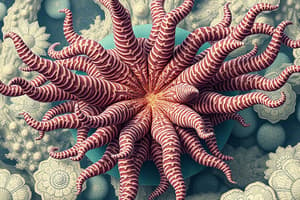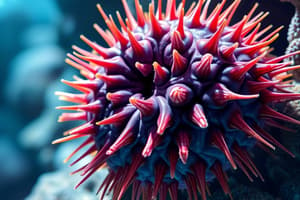Podcast
Questions and Answers
What characteristic differentiates Echinodermata from Arthropoda?
What characteristic differentiates Echinodermata from Arthropoda?
- Complete digestive system
- Jointed exoskeleton
- Water vascular system (correct)
- Complex muscular system
Which of the following classes is NOT part of the Phylum Echinodermata?
Which of the following classes is NOT part of the Phylum Echinodermata?
- Asteroidea
- Crinoidea
- Ophiuroidea
- Chelonia (correct)
What process do Arthropods undergo to grow?
What process do Arthropods undergo to grow?
- Metamorphosis
- Ecdysis (correct)
- Budding
- Fission
Which statement is true regarding the digestive system of Arthropoda?
Which statement is true regarding the digestive system of Arthropoda?
What do the tube feet of Echinodermata primarily assist with?
What do the tube feet of Echinodermata primarily assist with?
What type of symbiotic relationship is exhibited by the Red-banded coral shrimp?
What type of symbiotic relationship is exhibited by the Red-banded coral shrimp?
Which of the following crustacean orders includes lobsters and shrimps?
Which of the following crustacean orders includes lobsters and shrimps?
What is the function of haemocyanin in arthropods and molluscs?
What is the function of haemocyanin in arthropods and molluscs?
Which class of arthropods includes animals such as spiders and scorpions?
Which class of arthropods includes animals such as spiders and scorpions?
Which animal is not included in the class Malacostraca as mentioned in the content?
Which animal is not included in the class Malacostraca as mentioned in the content?
What is the main characteristic feature of the Class Isopoda mentioned?
What is the main characteristic feature of the Class Isopoda mentioned?
What distinguishes the eyes of arthropods, particularly the compound eye?
What distinguishes the eyes of arthropods, particularly the compound eye?
What process do arthropods undergo to grow and develop, characterized by shedding their exoskeleton?
What process do arthropods undergo to grow and develop, characterized by shedding their exoskeleton?
What does the term 'tagma' refer to in arthropod anatomy?
What does the term 'tagma' refer to in arthropod anatomy?
What type of appendages do ancestral forms of Arthropoda possess?
What type of appendages do ancestral forms of Arthropoda possess?
Which class of crustaceans includes barnacles?
Which class of crustaceans includes barnacles?
What component of the exoskeleton of Arthropoda includes nitrogen?
What component of the exoskeleton of Arthropoda includes nitrogen?
What is the mode of reproduction for modern onychophorans?
What is the mode of reproduction for modern onychophorans?
Which characteristic is NOT found in brittle stars (Class Ophiuroidea)?
Which characteristic is NOT found in brittle stars (Class Ophiuroidea)?
What process is used by clam predators to access their meals?
What process is used by clam predators to access their meals?
Which group is considered paraphyletic among crustaceans?
Which group is considered paraphyletic among crustaceans?
What type of limbs do ancient onychophorans possess?
What type of limbs do ancient onychophorans possess?
What characteristic is shared by the class Branchiopoda?
What characteristic is shared by the class Branchiopoda?
Which of the following organisms is an indicator of pollution and belongs to the class Branchiopoda?
Which of the following organisms is an indicator of pollution and belongs to the class Branchiopoda?
What is a notable impact of the Caribbean barnacle Chthamalus proteus?
What is a notable impact of the Caribbean barnacle Chthamalus proteus?
Which of the following statements about barnacles is true?
Which of the following statements about barnacles is true?
In what type of environment does Artemia salina thrive?
In what type of environment does Artemia salina thrive?
Flashcards are hidden until you start studying
Study Notes
Phylum Echinodermata
- Deuterostomes; exclusively marine organisms
- Unique water vascular system utilizing tube feet and pedicellariae
- Exhibit pentaradial symmetry
- Major classes include:
- Echinoidea: Sea urchins
- Crinoidea: Crinoids
- Holothuroidea: Sea cucumbers
- Asteroidea: Starfish
- Ophiuroidea: Brittle stars
- Tariffs with calcareous tests composed of small plates or spicules
Arthropoda Overview
- Characterized by jointed exoskeleton and appendages, offering advantages like mobility
- Hard shell composed of chitin, vital for protection and structural support
- Segmentation allows for fusion into specialized body regions (tagmosis)
- Open circulatory system where haemolymph circulates through haemocoel
- Possess simple and compound eyes for varied visual capabilities
- Complete digestive system enabling efficient nutrient processing
- Respiration occurs through the body surface, supporting metabolic functions
- Bilateral symmetry with a dorsal brain linked to ventral ganglia
- Growth occurs via ecdysis (moulting) to accommodate body size increase
Ecdysozoan Phylogeny
- Includes over 1.5 million described insect species; estimates suggest 10 to 30 million total species
- Phylum Onychophora (velvet worms) may represent early arthropod ancestors
Classifications within Phylum Arthropoda
- Crustaceans compose the most basal group; include:
- Class Malacostraca: Lobsters, crabs, woodlice
- Class Maxillopoda: Barnacles
- Class Branchiopoda: Water fleas
- Chelicerates encompass:
- Class Arachnida: Spiders, scorpions, and mites
- Class Merostomata: Horseshoe crabs
- Myriapods consist of:
- Class Chilopoda: Centipedes
- Class Diplopoda: Millipedes
- Hexapods include:
- Class Entognatha: Springtails
- Class Insecta: True insects
Tagmosis and Body Structure
- Tagmosis involves regional specialization through the fusion of segments
- Common body structures include antennae, mouthparts, claws, and walking legs
Crustacean Larvae
- Nauplius and Zoea are notable larvae forms with distinct life cycles and low competition with adults
Economic Importance of Malacostraca
- Crustaceans like the Caribbean spiny lobster and various crabs are vital for fisheries and human consumption
- Specific species such as Cardisoma guanhumi (Blue land crab) are significant in local fisheries
Class Branchiopoda
- Includes brine shrimps which depend on multiple legs for swimming and filter feeding
- Daphnia species serve as pollution indicators and fish food sources
Class Maxillopoda
- Barnacles are described as shrimp-like creatures attached to surfaces, essential in marine ecosystems
- Can significantly impact ship speeds due to their presence on hulls
Sensory and Movement Adaptations
- Arthropods possess mechanoreceptors and have specialized antenna types for enhanced touch and chemical detection
Studying That Suits You
Use AI to generate personalized quizzes and flashcards to suit your learning preferences.




